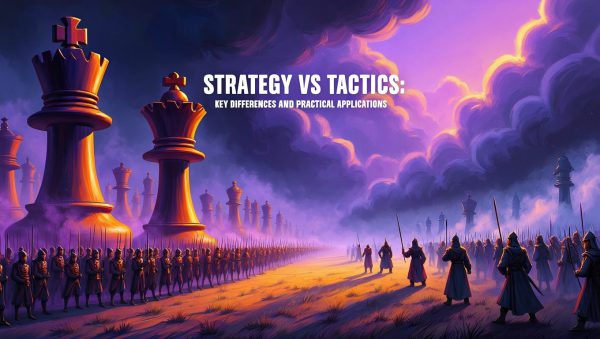
Strategy vs Tactics Examples You Need to Know!
Mar 28, 2025
Have you ever wondered why some investors thrive in the chaos of market turmoil, while others are swept away by the tide of collective panic? The answer lies not merely in numbers or charts, but in understanding a fundamental distinction that separates the wise investor from the reckless speculator: the crucial difference between strategy and tactics. Grasping this distinction is not academic—it is transformative. It can mean the difference between long-term prosperity and financial ruin.
Financial markets are driven by human emotion: fear, greed, optimism, and panic. These emotions fuel bubbles, crashes, and irrational behaviours that define market cycles throughout history. Those who fail to recognise this truth risk being swept along by the herd, making impulsive decisions driven by fear or greed rather than disciplined strategy. Conversely, investors who understand the psychological undercurrents that shape market behaviour and who distinguish clearly between strategy and tactics can turn collective panic into opportunity—leveraging volatility to build enduring wealth.
Understanding Strategy and Tactics: A Crucial Distinction
Many investors confuse strategy with tactics, but understanding the difference is essential. Strategy represents your overarching vision, long-term investment philosophy, and disciplined approach to wealth accumulation. It defines your ultimate goals, risk tolerance, and core principles guiding investment decisions over years or even decades. Strategy is rooted in timeless wisdom, disciplined analysis, and emotional resilience.
Tactics, by contrast, are specific actions taken to implement your strategy in response to short-term market conditions. Tactical decisions include selecting individual stocks, timing specific trades, adjusting portfolio allocations, or employing particular investment techniques such as options trading or dollar-cost averaging. Tactics are adaptable, flexible, responding dynamically to evolving market circumstances.
Yet, tactics alone, without a disciplined underlying strategy, lead investors astray. Investors who focus excessively on short-term tactical decisions—attempting to predict market fluctuations or time entry points perfectly—often fall victim to emotional impulses, irrational biases, and herd behaviour. Strategy provides the disciplined framework necessary to guide tactical decisions, ensuring alignment with long-term objectives even amidst short-term volatility.
Mass Psychology and Market Crashes: Lessons from History
Financial markets are profoundly influenced by collective psychology. Investor emotions—fear, greed, optimism, and panic—drive market cycles, creating speculative bubbles, devastating crashes, and irrational behaviours. Mass psychology provides crucial insights into market behaviour, empowering investors to navigate volatility effectively.
Cognitive biases shape investor decisions in predictable yet irrational ways. Loss aversion—the psychological tendency to fear losses disproportionately more than equivalent gains—fuels panic selling during market downturns. Investors, driven by fear rather than rational analysis, liquidate positions indiscriminately, exacerbating market declines.
Confirmation bias, the tendency to seek information supporting existing beliefs, further exacerbates irrational behaviour. During speculative bubbles, investors selectively focus on optimistic narratives, ignoring warning signals and mounting risks. Herd mentality accelerates collective panic during market crashes, magnifying volatility as investors instinctively follow the crowd.
Historical market crashes vividly illustrate mass psychology in action. The speculative frenzy of the 1929 Wall Street Crash, the dot-com bubble of 2000, and the financial crisis of 2008 all demonstrated collective emotional extremes driving irrational investment decisions. Understanding mass psychology equips investors to resist herd behaviour, maintain disciplined strategy, and capitalise on volatility.
Contrarian Courage: Strategic Advantage Amidst Panic
Contrarian investing embodies disciplined strategy and psychological resilience. Contrarian investors deliberately act opposite prevailing market sentiment, resisting emotional impulses and maintaining rational judgment amidst collective panic. This approach requires intellectual conviction and emotional fortitude, enabling investors to capitalise on market volatility strategically.
Legendary investor Warren Buffett famously advises, “Be fearful when others are greedy and greedy when others are fearful.” This contrarian wisdom encapsulates the disciplined strategy necessary to navigate volatile markets effectively. During market downturns, disciplined contrarians recognise collective fear as opportunity, strategically purchasing fundamentally strong assets temporarily discounted by emotional panic selling. Conversely, during speculative bubbles, contrarians maintain cautious discipline, avoiding excessive valuations driven by collective greed.
During the 2008 financial crisis, disciplined contrarians recognised panic selling as irrational, strategically purchasing high-quality assets at deeply discounted valuations. As markets stabilised and recovered, these disciplined investors profited significantly, validating contrarian wisdom amidst market turmoil.
Hybrid Strategies for Navigating Volatility
Beyond traditional contrarian investing, sophisticated investors employ hybrid strategies combining disciplined and adaptable tactics to navigate market volatility effectively. One powerful hybrid approach involves selling put options during volatility spikes, generating substantial premiums driven by elevated fear-driven volatility.
During market downturns, investors strategically sell cash-secured put options on fundamentally strong companies, collecting inflated premiums due to heightened volatility. Either outcome benefits sellers: if prices stabilise or rise, they retain premium income; if prices decline further, they acquire shares at deeply discounted valuations, positioning themselves advantageously for eventual market recoveries.
Investors can further leverage hybrid strategies by reinvesting inflated put premiums into long-term equity anticipation securities (LEAPS)—long-dated call options providing leveraged exposure to potential market rebounds. This combined strategy enables investors to generate premium income during periods of emotional volatility while establishing leveraged positions benefiting exponentially from future market recoveries.
Advanced and Alternative Approaches: Leveraging Market Psychology
For risk-tolerant investors seeking exponential gains, advanced and alternative strategies offer compelling opportunities to leverage market psychology effectively. During speculative bubbles, disciplined investors strategically identify divergences—technical indicators signalling waning momentum despite rising prices—as early warning signals indicating potential market reversals.
Technical indicators such as Relative Strength Index (RSI) divergences, Moving Average Convergence Divergence (MACD), and volume analysis provide disciplined investors with actionable insights into market psychology. Investors strategically sell covered calls or trim positions when technical divergences signal mounting risks amidst speculative excess.
Conversely, during market downturns, disciplined investors use technical indicators to pinpoint market entry points amidst collective panic selling. Investors strategically employ dollar-cost averaging, systematically purchasing fundamentally strong assets at discounted valuations during periods of emotional volatility.
Disciplined investors further capitalise on market psychology by reinvesting option premiums generated during volatility spikes into speculative high-beta positions, creating asymmetric risk-reward opportunities benefiting exponentially from eventual market rebounds.
Timeless Wisdom Meets Modern Tactics: Strategic Clarity Amidst Volatility
Ultimately, disciplined investors combine timeless philosophical insights with modern tactical strategies to navigate market volatility effectively. Ancient Stoic philosophers emphasised emotional detachment, rational analysis, and disciplined self-control as essential virtues for navigating uncertainty. These timeless insights resonate profoundly in financial markets, where disciplined strategy requires emotional resilience amidst volatility.
Modern behavioural economics further emphasises the pervasive influence of cognitive biases on investor behaviour. Investors must cultivate deliberate strategies to counteract biases such as loss aversion, confirmation bias, and herd mentality. Rigorous practice, disciplined risk management, and psychological resilience provide practical tools for navigating volatility strategically.
Empowering Independent Thinking and Strategic Clarity
Understanding the crucial distinction between strategy and tactics empowers investors to transcend emotional herd behaviour, cultivating independent thinking and strategic clarity. Recognising the profound influence of emotions on market decisions enables investors to resist biases, making deliberate, informed choices based on rational analysis.
Independent thinking requires challenging prevailing market narratives, questioning conventional wisdom, and maintaining intellectual humility. Investors must remain open to contrary evidence, adapting flexibly as market conditions evolve. By developing frameworks for rigorous analysis and disciplined execution, investors can confidently navigate markets even amidst emotional extremes.
Fostering strategic clarity involves clearly defining investment objectives, understanding personal risk tolerance, and establishing disciplined decision-making processes. Investors should explicitly account for emotional biases, incorporating safeguards against irrational reactions driven by market volatility, ensuring clarity and decisiveness even during turbulent market periods.
Conclusion: Strategy and Tactics—Transforming Volatility into Opportunity
The distinction between strategy and tactics reveals profound insights into human psychology and market behaviour. By understanding this crucial difference, investors gain powerful tools for navigating financial markets effectively. Embracing disciplined strategies, employing adaptable tactics, and maintaining psychological resilience empower investors to transform market volatility into strategic advantage.
Yet, beyond financial markets, these insights offer broader lessons for navigating uncertainty in all areas of life. Recognising emotions’ pervasive influence enables individuals to make deliberate, informed choices rather than reactive decisions driven by fear or impulsivity. Cultivating psychological resilience, independent thought, and strategic clarity empowers individuals to thrive amidst uncertainty and volatility, transforming challenges into opportunities for growth and success.
Ultimately, you face a clear choice: remain captive to emotional market behaviour or harness the profound insights of disciplined strategy and adaptable tactics to invest with confidence, clarity, and strategic foresight. In doing so, you transform volatility from threat into opportunity, positioning yourself decisively for enduring success in markets and life alike.
In the timeless wisdom of history’s greatest thinkers, true success stems not from short-term impulses but from disciplined strategy, emotional resilience, and strategic clarity. Understanding the crucial distinction between strategy and tactics empowers investors to transcend emotional extremes, harness market psychology, and position themselves decisively for enduring financial success.










